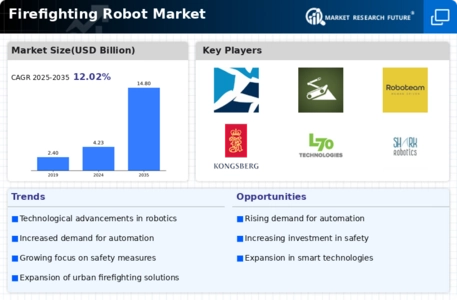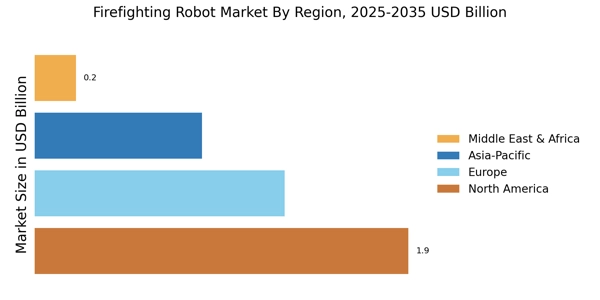Increased Demand for Safety
The Firefighting Robot Market is witnessing an increased demand for safety measures in firefighting operations. As urbanization continues to rise, the complexity and frequency of fire incidents have escalated, necessitating innovative solutions. Firefighting robots are increasingly viewed as essential tools for enhancing safety protocols, particularly in hazardous environments where human intervention poses significant risks. The market data indicates that the demand for firefighting robots is expected to reach USD 1.5 billion by 2026, reflecting a growing recognition of their role in safeguarding lives and property. This heightened focus on safety is prompting fire departments and emergency services to invest in robotic technologies, thereby driving the growth of the firefighting robot market. The ability of these robots to operate in extreme conditions, such as toxic smoke or high temperatures, further underscores their importance in modern firefighting strategies.
Government Initiatives and Funding
The Firefighting Robot Market is significantly influenced by government initiatives and funding aimed at enhancing firefighting capabilities. Various governments are recognizing the potential of robotic technologies in improving emergency response and are allocating resources to support research and development in this field. For instance, funding programs are being established to encourage innovation in firefighting robotics, which is expected to lead to the introduction of more advanced and effective solutions. As of 2025, it is estimated that government investments in firefighting technologies could exceed USD 500 million, reflecting a commitment to improving public safety. These initiatives not only foster technological advancements but also stimulate market growth by creating a favorable environment for the adoption of firefighting robots across different regions.
Adaptability to Diverse Environments
The Firefighting Robot Market benefits from the adaptability of robots to various environments, which is crucial for effective firefighting. These robots are designed to operate in diverse settings, including urban areas, industrial sites, and wildland environments. Their versatility allows them to tackle different types of fires, from structural fires in buildings to wildfires in remote areas. As of 2025, the market is projected to expand due to the increasing frequency of wildfires, which have prompted the development of specialized firefighting robots. These robots can traverse rugged terrains and access hard-to-reach locations, making them invaluable in emergency response scenarios. The ability to deploy robots in various environments not only enhances firefighting capabilities but also optimizes resource allocation, thereby contributing to the overall efficiency of firefighting operations.
Technological Advancements in Robotics
The Firefighting Robot Market is experiencing a surge in technological advancements, which significantly enhances the capabilities of firefighting robots. Innovations in artificial intelligence, machine learning, and sensor technologies are enabling these robots to navigate complex environments autonomously. For instance, the integration of thermal imaging cameras allows robots to detect heat sources and identify hotspots in real-time. As of 2025, the market is projected to grow at a compound annual growth rate of approximately 15%, driven by these technological improvements. Furthermore, advancements in battery technology are extending operational durations, making firefighting robots more effective in prolonged emergency situations. This evolution in technology not only improves efficiency but also reduces risks to human firefighters, thereby increasing the adoption of robotic solutions in firefighting operations.
Rising Insurance Costs and Liability Concerns
The Firefighting Robot Market is also driven by rising insurance costs and liability concerns associated with firefighting operations. As fire incidents become more frequent and severe, insurance premiums for fire departments and businesses are increasing, prompting a reevaluation of firefighting strategies. The integration of firefighting robots is seen as a proactive measure to mitigate risks and reduce potential liabilities. By deploying robots in high-risk situations, organizations can minimize the likelihood of injuries to personnel and damage to property, which may lead to lower insurance costs over time. Market analysis suggests that the adoption of robotic firefighting solutions could lead to a reduction in claims, thereby appealing to insurance providers. This financial incentive is likely to encourage more fire departments to invest in firefighting robots, further propelling market growth.


















Leave a Comment